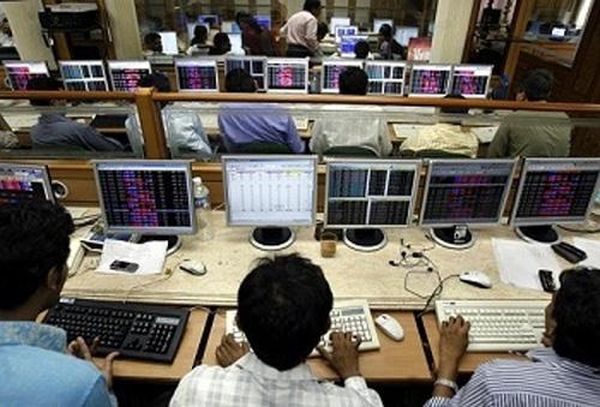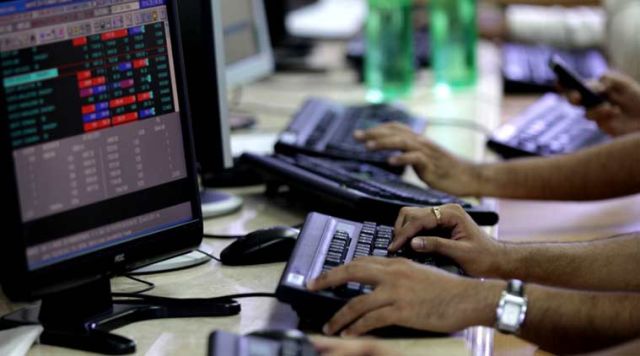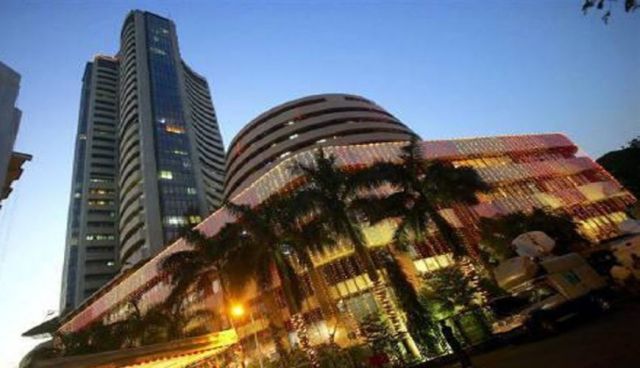
by admin | May 25, 2021 | Economy, Markets, News
 Mumbai : Despite earlier gains, the key Indian equity indices closed in the red on Tuesday as banking stocks tanked substantially and investors also continued to trade with caution.
Mumbai : Despite earlier gains, the key Indian equity indices closed in the red on Tuesday as banking stocks tanked substantially and investors also continued to trade with caution.
The barometer 30-scrip Sensitive Index (Sensex) of the BSE closed at 33,317.20 points — down 429.58 points, or 1.27 per cent, from its previous close of 33,746.78 points.
Similarly, the wider Nifty50 of the National Stock Exchange (NSE) also plummeted by 109.60 points, or 1.06 per cent, to close at 10,249.25 points.
In the intra-day, the S&P BSE Sensex touched a high of 34,060.13 points and a low of 33,209.76 points.
“Early positivity that rode on global markets’ pull back proved to be brief, as turmoil in banking sector and persistent selling by FIIs dragged stocks lower,” said Anand James, Chief Market Strategist, Geojit Financial Services.
Banking stocks fell as ICICI Bank chief Chanda Kochhar and Axis Bank’s Shikha Sharma had been summoned by Serious Fraud Investigation Office in Mumbai in the bank fraud case involving jeweller Nirav Modi and his partner and uncle Mehul Choksi.
“Market gave up gains despite positive trade in global market. Consolidation continues led by broad selling across all sector. Market has broken ye’terday’s low while banks continue to struggle due to NPA issue, higher bond yield & cost of funds. Investors are little nervous to start accumulating and are waiting for major triggers to get direction,” said Vinod Nair, Head of Research, Geojit Financial Services.
Sector-wise, almost all the sectors ended in red. Major selling pressure was seen in banking, capital goods, auto and realty sectors.
S&P BSE banking index plummeted by 1.44 per cent, capital goods index by 1.31 per cent, auto index by 1.36 per cent and realty index by 2.21 per cent.
Only consumer durables sector remained in the green.
There were only three Sensex gainers on Tuesday: IndusInd Bank, up 1.21 per cent at Rs 1,707.10; Tata Steel, up 0.79 per cent at Rs 660.50 and Hero MotoCorp, up 0.35 per cent at Rs 3,570.
The major Sensex losers were: Sun Pharma, down 2.95 per cent at Rs 531.70; State Bank of India, down 2.77 per cent at Rs 256.50; ICICI Bank, down 2.64 per cent at Rs 295.10 and Mahindra and Mahindra, down 2.52 per cent at Rs 720.35.
—IANS

by admin | May 25, 2021 | Economy, News, Opinions

For representational purpose only
By Amit Kapoor,
The developing wave of economic nationalism across the world has reached disconcerting levels. President Donald Trump’s recent move to raise tariffs on import of steel and aluminium into the US signalled the pinnacle of the global shift towards protectionism.
To be fair, the US is the least protectionist large economy in the world and singling it out might seem hypocritical, especially by more protectionist nations. However, the point remains that there simply exists no economic logic behind the move. There are no economic gains to be made, even by the US, through higher tariffs. Moreover, the costs for the US and the world far outweigh the benefits that can be had from them.
Take the US economy. The tariffs have been imposed to pander to the sentiments of Americans who have been led to believe that their jobs are being taken away by cheap labour in emerging economies. However, the immediate impact of raised tariffs would be a rise in steel and aluminium prices in the US as firms cannot expand capacity overnight. So, the cost of goods that use these products as inputs will rise and be passed on to the consumers. In turn, if they decide to reduce their consumption due to rising prices, jobs will be lost in the process.
Moreover, according to the US Bureau of Labour Statistics, the number of Americans employed in sectors that consume steel and aluminium far outnumber those that are directly employed in those sectors. The costs borne by Americans due to a rise in inflation would, therefore, far outweigh any gains that the people employed in the industries concerned would make. So, raising tariffs of these sectors is either ill-thought-out or no more than a political gimmick to appease the voter base.
Now, consider the world economy. China was the obvious target of the move, considering the fact that it is the world’s largest steel exporter and has been widely accused of dumping cheap steel in global markets. However, China has been reducing its overcapacity in the steel sector due to ecological and economic reasons — shutting down about 50 million tonnes of its production in 2017. To put things in perspective, the US imported less than a million tonnes of steel last year. Therefore, US tariffs would hardly affect the US economy.
Instead, Trump will end up hurting his closest global allies in Canada, South Korea, Japan and the EU. The three countries will be affected on account of being the largest suppliers of steel to the US, while the EU fears that exports meant for the US would now be diverted to Europe and affect local producers. This might force retaliatory tariffs from countries around the world and, in an unlikely eventuality, could also result in a full-blown trade war.
Even if no trade wars ensue, the economics of protectionism does not hold water in an already globalised world. First, international commerce is now driven by knowledge flows that are not affected by tariffs. Second, manufacturing is dependent on global supply chains, which Trump means to attack. However, in economist Richard Baldwin’s words, imposing tariffs is like building a wall in the middle of the factory floor that only decreases efficiency of production and benefits no market.
Finally, the era when countries were building on the foundation of manufacturing jobs is nearing its end. As automation and robotics make rapid advancements, the nature of work is fast changing and the protectionists that promise the return to past glory of the 20th-century factory floors are selling nothing but snake oil.
India has also shown a growing proclivity towards protectionism, most recently in the Union Budget that increased customs duty in more than 10 sectors. However, the same arguments hold true for India as well. In fact, in 2016 India raised tariffs on imported steel to protect domestic producers against cheap Chinese imports. However, manufacturing firms using steel inputs lost their export markets and had to lay off workers.
More importantly, India cannot hope for a manufacturing revolution that defined the economic success stories of East Asia and even China. Quite a significant proportion of blue-collar jobs will be lost to automation and modern emerging economies have to adapt to these conditions. Countries that choose to close themselves off to foreign competition are bound to lose their innovative edge. Such inward-looking policies have not helped in the past and they are not expected to do so now.
The perception that globalisation is a zero-sum game needs to be dropped as it has repeatedly been seen that open borders have been beneficial for most stakeholders. A better strategy would be to improve social security of workers exposed to risk in open markets, as the Nordic countries have successfully done. The political mood of restoration of past glory needs to be dropped. The times call for evolutionary transformation.
(Amit Kapoor is Chair, Institute for Competitiveness, India. He can be contacted at Amit.Kapoor@competitiveness.in and tweets @kautiliya. Chirag Yadav, senior researcher at the Institute has contributed to the article)
—IANS

by admin | May 25, 2021 | Economy, Markets, News
 Mumbai : Negative global cues — on the prospect of trade wars and protectionism — pulled the key indices of the Indian equity market lower on Monday.
Mumbai : Negative global cues — on the prospect of trade wars and protectionism — pulled the key indices of the Indian equity market lower on Monday.
According to market observers, heavy selling pressure was witnessed in metals, oil and gas, auto, capital goods and banking stocks.
Consequently, the barometer 30-scrip Sensitive Index (Sensex) of the BSE closed the day’s trade at 33,746.78 points — down 300.16 points, or 0.88 per cent, from its previous close of 34,046.94 points.
Similarly, the wider Nifty50 of the National Stock Exchange (NSE) edged-lower on Monday. It closed lower by 99.50 points, or 0.95 per cent, to close at 10,358.85 points.
“Markets corrected further on Monday falling for the fourth straight session. Private survey data which showed deterioration in India’s services sector activity last month hit investor sentiments. Also fears that US President Donald Trump’s announced tariffs on steel and aluminium could spark a trade war led to sharp falls in Metal and Mining stocks,” said Deepak Jasani, Head – Retail Research, HDFC Securities.
“Weakness in Asian stock markets as investors digested the latest growth forecast for China (6.5 per cent for 2018, same as in 2017) also affected sentiments. Nifty finally closed 0.95 per cent lower at 10,359 points.”
As per Anand James, Chief Market Strategist, Geojit Financial Services: “Domestic market succumbed to the pressure exerted by global peers, concerned over talks over likely hike in US import tariff on steel and aluminium.”
“Metal sector has taken the biggest hit so far, but Indian exporters would look at the dawning possibility of a of a global trade war, adding to the anxiety of the investors awaiting outcomes of major Central banks meetings this week. Heavy FII outflow during February and the persistent NPA issues in the banking sector also continuous to worry the domestic investors.”
On the currency front, the Indian rupee stregthened to close at 65.11 against the US dollar from its previous close at 65.17-18.
In terms of investments, provisional data with the exchanges showed that foreign institutional investors sold scrip worth Rs 366.60 crore, while domestic institutional investors off-loaded stocks worth Rs 154.20 crore.
“Sectorally, top gainers were IT and PSU Bank indices. Top losers were Metal, Auto, FMCG and Realty indices. Stockwise, BEML, Mindtree, IDBI and Tech Mah have moved higher while Balrampur Chini, NMDC, Nalco and Tata Motors have moved lower,” Jasani said.
Sector-wise, S&P BSE metals index receded by 495.82 points, automobile index by 385.15 points, oil and gas index by 281.45 points, capital goods index by 187.42 points and FMCG index by 130.74 points.
However, IT and ITES index remained in the green.
Major Sensex gainers on Monday were: Sun Pharma, up 2.50 per cent at Rs 547.85; Tata Consultancy Services (TCS), up 2.21 per cent at Rs 3,104.30; Mahindra and Mahindra, up 0.81 per cent at Rs 738.95, State Bank of India, up 0.48 per cent at Rs 263.80 and Kotak Bank, up 0.25 per cent at Rs 1,098.90.
The Sensex losers were: Tata Motors, down 5.04 per cent at Rs 325.15; Tata Motors (DVR), down 3.92 per cent at Rs 199.70; Tata Steel, down 2.95 per cent at Rs 655.35; Bajaj Auto, down 2.74 per cent at Rs 2,942.10; and Reliance Industries, down 2.48 per cent at Rs 924.20.
—IANS

by admin | May 25, 2021 | Economy, Markets, News
 By Rohit Vaid,
By Rohit Vaid,
Mumbai : Further economic reforms expected from the second-half of the Budget session and volatility in global stock markets will influence the trajectory of the key Indian equity indices next week, opined analysts.
Further, market observers pointed out that crude oil price fluctuations, combined with the stress being faced by the banking sector, direction of foreign fund flows and the rupee’s movement against the US dollar, will also impact investors’ risk-taking appetite.
“Next week, markets would closely track the movement in the banking index, especially the PSU bank stocks, for any recovery — and capital goods stocks,” Devendra Nevgi, Founder and Principal Partner, Delta Global Partners, told IANS.
“The global market sentiment and FPI (Foreign Portfolio Investors) flows would be closely watched, as, in the month of February, FPIs were net sellers to the tune of Rs 18,619 crore.”
“The DII (Domestic Institutional Investors) support remains crucial for markets. (February net purchases of Rs 17,813 crore.)”
According to Vinod Nair, Head of Research, Geojit Financial Services, the long-term outlook for the economy “continues to be strong, while valuation for the market is still high”.
“Prevailing volatility in the market is due to concerns on inflation, rise in 10-year bond yield and US Federal Reserve’s rate hike trajectory,” he said.
Besides global cues, investors are expected to keep a close watch on the upcoming macro-economic data point — the Nikkei India Composite PMI Output Index — and the rupee’s movement against the US dollar.
On the currency front, the rupee weakened by 96 paise to close at 65.17 against the US dollar for the week ended March 1.
“News of BJP doing well in the assembly polls in three key North East states augurs well for political stability. We are in a pre-election year, where every small and large victory will get bigger than usual importance. As a result, we expect the rupee to strengthen towards 65 levels during the first half of the week,” Anindya Banerjee, Deputy Vice President for Currency and Interest Rates with Kotak Securities, told IANS.
“Weakness in the US dollar, post Trump’s announcement on trade tariffs, should add momentum to the long rupee trade. On USD-INR, we are expecting a range of 64.70 to 65.30 levels on spot.”
On technical levels, the underlying short-term trend of the National Stock Exchange’s (NSE) Nifty50 remains bearish.
“Technically, with the Nifty resuming its short-term downtrend after a minor pullback witnessed last week, the underlying trend remains down,” said Deepak Jasani, Head of Retail Research for HDFC Securities.
“Further downsides are likely once the immediate supports of 10,422 points are broken.”
Last week, despite better-than-expected macro-economic growth indicators, the key Indian equity indices closed the week on a flat-to-negative note as global cues and the stress faced by the banking sector, eroded investors’ risk-taking appetite.
However, a minor pullback rally led by healthy GDP growth data for the third quarter of 2017-18 helped pare some losses in the truncated week that ended Thursday, with Holi being celebrated on Friday.
Consequently, on a weekly basis, the barometer 30-scrip Sensitive Index (Sensex) of the Bombay Stock Exchange (BSE) declined by 95.21 points or 0.28 per cent to close at 34,046.94 points.
Similarly, the wider Nifty50 of the NSE closed slightly in the red. It closed at 10,458.35 points — down by just 32.7 points or 0.31 per cent from its previous week’s close.
(Rohit Vaid can be contacted at rohit.v@ians.in)
—IANS

by admin | May 25, 2021 | Business, Commodities, Commodities News, Corporate, Corporate Governance, Economy, Large Enterprise, Markets, News
 New Delhi : Its double cheer for Indian government ahead of Holi on Wednesday as the GDP and Eight Core Industries (ECI) data showed signs of economic recovery but fiscal deficit data played the spoilsport at 113.7 per cent of the full year’s target.
New Delhi : Its double cheer for Indian government ahead of Holi on Wednesday as the GDP and Eight Core Industries (ECI) data showed signs of economic recovery but fiscal deficit data played the spoilsport at 113.7 per cent of the full year’s target.
A pick-up in the country’s manufacturing sector accelerated India’s third quarter GDP growth of 2017-18 to 7.2 per cent from a rise of 5.2 per cent achieved in the second quarter, official data showed.
According to the second advance estimates of national income at constant (2011-12)and current prices for the financial year 2017-18, the GDP growth rate of the entire fiscal 2017-18 was revised upward to 6.6 per cent.
“The Real GDP at constant (2011-12) prices in the year 2017-18 is likely to attain a level of Rs 130.04 lakh crore, as against the first revised estimate of GDP for the year 2016-17 of Rs 121.96 lakh crore, released on January 31, 2018,” the second advance estimates showed.
“The growth in GDP during 2017-18 is estimated at 6.6 percent as compared to the growth rate of 7.1 percent in 2016-17.”
The data released by the Ministry of Statistics and Programme Implementation showed that the growth in country’s quarterly GDP came on the back of a healthy pick-up in manufacturing activity which grew at 8.1 per cent.
The third quarter GDP growth, helped by manufacturing, construction and agriculture paint a pretty good macro picture for Indian economy, industry body ASSOCHAM said.
“The 7.2 per cent growth in GDP for Q3 also highlights an improvement in investment, manufacturing and construction thereby giving hope for a good pace of economic growth in the next fiscal, as the stage is now set in FY2017-18,” said D.S. Rawat, Secretary General, ASSOCHAM.
Also the pace of India’s eight major industries’ output accelerated in January to 6.7 per cent from an increase of 4 per cent in December 2017 and 3.4 per cent in the corresponding month of the previous fiscal, official data revealed.
“The combined Index of ECI stands at 133.1 in January, 2018, which was 6.7 per cent higher as compared to the index of January, 2017,” the Ministry of Commerce & Industry said.
“Its cumulative growth during April to January, 2017-18 was 4.3 per cent.”
The ECI index represents the output of major sectors like coal, steel, cement and electricity and carries 40.27 per cent weightage of the Index of Industrial Production which is the macro-gauge for India’s factory output.
However, India’s fiscal deficit for April-January period of 2017-18 stood at 113.7 per cent of the full year’s target, official data showed.
The data furnished by the Comptroller General of Accounts showed that during April-January, the fiscal deficit stood at Rs 6.77 lakh crore, which is 113.7 per cent of the full year’s target.
The capital expenditure during the period stood at Rs 2.64 lakh crore. The revenue deficit during the period was at 4.8 lakh crore, revealed the data.
While the Nikkei India Manufacturing Purchasing Managers’ Index (PMI), a composite indicator of manufacturing performance, fell to 52.1 from 52.4 in January 2018, though it remain in positive territory. Everything above 50 shows a positive indication.
Business conditions of India’s manufacturing sector improved in February, but at a slower pace from January.
—IANS

 Mumbai : Despite earlier gains, the key Indian equity indices closed in the red on Tuesday as banking stocks tanked substantially and investors also continued to trade with caution.
Mumbai : Despite earlier gains, the key Indian equity indices closed in the red on Tuesday as banking stocks tanked substantially and investors also continued to trade with caution.



